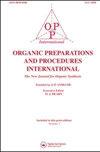Improved Preparation on Decagram Scale of 5,8-Dihydro-4,6-dihydroxy-5,8-dioxoquinoline-2-carboxylic Acid, a Key Intermediate of Pirenoxine
IF 1.6
4区 化学
Q4 CHEMISTRY, ORGANIC
Organic Preparations and Procedures International
Pub Date : 2022-01-01
DOI:10.1080/00304948.2022.2106107
引用次数: 0
Abstract
Pirenoxine (Scheme 1, (1)) is a medication used in the treatment and prevention of cataracts. Pirenoxine is sold under the trade name Catalin. Pirenoxine (1) is prepared by the condensation of 5,8-dihydro-4,6-dihydroxy-5,8-dioxoquinoline-2-carboxylic acid (2) with 2-aminophenol in acetic acid as shown in Scheme 1. According to the literature, 5,8-dihydro-4,6-dihydroxy-5,8-dioxoquinoline-2-carboxylic acid (2) is in turn prepared by the oxidation of 4,5,6,8-tetrahydroxyquinoline-2carboxylic acid (4) in the presence of potassium ferricyanide and sulfuric acid in water as shown in Scheme 2 (a). However, the major disadvantage of this synthesis is the use of potassium ferricyanide. Along with the high cost, the reaction between potassium ferricyanide and sulfuric acid may lead to the production of inherently hazardous hydrogen cyanide gas. Hence, this synthesis is not preferable for large scale production. In this context, a facile, economical, safe and industrially viable preparation of 2 has been developed from 4,5,6,8-tetrahydroxyquinoline-2-carboxylic acid (4) under solvent free conditions, and the preparation forms the basis of this report. In our approach, compound 4 is treated with inexpensive ferric chloride with sulfuric acid in water at 20-30 C as shown in Scheme 2 (b) (see Experimental section). On 50 gram scale, the product was obtained in 85% yield as a solid. This method produced a greater yield compared to that of the conventional method (64.5%). During the initial development, several reagents such as chromium trioxide, manganese dioxide, and potassium dichromate had also been tested for this oxidation reaction, but the oxidation reaction of 4 with ferric chloride in aqueous sulfuric acid was superior in forming the desired compound 2. Summing up, this new procedure replaces inherently hazardous and expensive potassium ferricyanide with inexpensive and eco-friendly ferric chloride for the preparation on decagram scale in very good yield of a key intermediate in the synthesis of Pirenoxine.吡诺酮关键中间体5,8-二氢-4,6-二羟基-5,8-二氧喹啉-2-羧酸的十元尺度改进制备
倍耐力(方案1,(1))是一种用于治疗和预防白内障的药物。倍耐力以商品名Catalin出售。如方案1所示,通过5,8-二氢-4,6-二羟基-5,8-二氧代喹啉-2-羧酸(2)与2-氨基苯酚在乙酸中的缩合制备吡喃酮(1)。根据文献,5,8-二氢-4,6-二羟基-5,8-二氧喹啉-2-羧酸(2)是通过4,5,6,8-四羟基喹啉-2羧酸(4)在铁氰化钾和硫酸存在下在水中氧化制备的,如方案2(a)所示。然而,这种合成的主要缺点是使用铁氰化钾。除了高成本外,铁氰化钾和硫酸之间的反应可能导致产生固有危险的氰化氢气体。因此,这种合成对于大规模生产是不优选的。在这种情况下,在无溶剂条件下,由4,5,6,8-四羟基喹啉-2-羧酸(4)制备了一种简单、经济、安全且在工业上可行的2的制剂,该制剂构成了本报告的基础。在我们的方法中,化合物4用廉价的氯化铁和硫酸在20-30℃的水中处理,如方案2(b)所示(见实验部分)。在50克的规模上,得到85%产率的固体产物。与传统方法(64.5%)相比,这种方法产生了更高的产率。在最初的开发过程中,也测试了几种试剂,如三氧化二铬、二氧化锰和重铬酸钾的氧化反应,但4与氯化铁在硫酸水溶液中的氧化反应在形成所需化合物2方面更为优越。总之,这一新工艺用廉价环保的氯化铁代替了固有的危险和昂贵的铁氰化钾,以非常好的产率在十克规模上制备了倍耐力合成中的一个关键中间体。
本文章由计算机程序翻译,如有差异,请以英文原文为准。
求助全文
约1分钟内获得全文
求助全文
来源期刊
CiteScore
2.60
自引率
13.30%
发文量
60
审稿时长
2 months
期刊介绍:
Organic Preparations and Procedures International (OPPI) publishes important, bimonthly research relevant to organic chemists engaged in synthesis. It is devoted to preparative organic chemistry, organometallic compounds, and procedures generally related to synthesis. The mission has always been to assist the practitioner by publishing reliable and reproducible procedures of the highest standards.
OPPI publishes articles in every area of preparative organic chemistry - from innovative technology to improvements in traditional synthesis. Along with experimental papers, the Journal publishes authoritative reviews on significant topics in synthesis.
The editors work closely with all authors, including those whose first language may not be English, to ensure important work is provided with clarity and a forum, giving OPPI a truly unique opportunity to serve a worldwide audience with valuable material.

 求助内容:
求助内容: 应助结果提醒方式:
应助结果提醒方式:


